If you’re considering taking your outdoor space to the next level, the following creative paver patio ideas might just be the inspiration you need to create a backyard retreat that’ll make your home the envy of the neighborhood =)
✨Click to Get My 101 FREE Designer Room Ideas
Multi-Level Magic: Creating Drama and Function with Elevated Patio Spaces


Nothing transforms a boring flat backyard faster than a multi-level paver patio that creates instant visual interest and practical room division.
Think of these elevated spaces as outdoor rooms without walls—a raised dining area flows into a sunken conversation pit, creating distinct areas for different activities.
The retaining walls required for these elevation changes double as built-in seating, eliminating the need for extra furniture while defining your space.
Even modest height differences of 8-12 inches between levels can dramatically change how your outdoor space feels, making it seem more expansive and intentionally designed.
Consider using contrasting paver colors or patterns between levels to further emphasize the dimensional quality of your new outdoor retreat.
For sloped properties, multi-level designs aren’t just beautiful—they’re practical solutions that transform problematic landscapes into showcase features.
Imagine a slightly elevated dining platform that offers improved views of your garden while keeping your eating space separate from lounging areas.
The transitions between levels—steps, gentle ramps, or curved approaches—become design features themselves, creating a sense of journey as guests move through your outdoor space.
These level changes provide perfect opportunities to incorporate lighting in unexpected ways, with recessed fixtures in stair risers or under-cap lighting on retaining walls.
For ultimate luxury, consider how water might move between your levels—perhaps a small cascade that creates soothing background sounds as it travels from an upper patio to a lower collection basin.
Children and pets naturally respond to these level changes, instinctively understanding the different “rooms” you’ve created without need for explicit boundaries.
For entertaining, multi-level designs allow different activities to happen simultaneously—perhaps a cooking and dining zone up top while conversation happens in a lower lounge area.
When planning these elevation changes, consider accessibility needs for all family members and guests, incorporating ramps or gentle transitions where appropriate.
The dimensional quality of a thoughtfully designed multi-level patio adds significant value to your property, transforming basic outdoor square footage into architectural living space.
During evening hours, these level changes create natural shadow play that adds depth and mystery to your outdoor lighting scheme.
For truly impressive designs, consider incorporating an elevated fire pit area where built-in seating creates a natural gathering spot visible from other parts of your yard.
Pattern Play: Using Geometric Designs to Create Showstopping Paver Floors


Forget boring grid layouts—geometric paver patterns instantly transform ordinary materials into extraordinary floor designs that become the star of your outdoor space.
Herringbone arrangements create dynamic visual movement that draws the eye across your patio, adding sophistication without requiring multiple paver colors.
Circular medallions placed strategically in your design create natural focal points, perfect for defining dining areas or anchoring conversation spaces.
Consider how classic basketweave patterns bring timeless appeal to traditional homes while still feeling fresh and intentionally designed.
The beauty of geometric patterns lies in their ability to make even affordable pavers look custom and high-end through thoughtful arrangement.
For dramatic impact, chevron layouts create bold directional patterns that make modest patios feel designer-worthy and visually expansive.
Mix paver sizes within your geometric design to create more complex patterns that reward closer inspection and look intentionally crafted rather than mass-produced.
Border details that frame your geometric pattern like artwork add definition to your space while creating visual boundaries without physical barriers.
For modern homes, consider grid patterns using large-format pavers with precise spacing that complements clean architectural lines.
The same pavers can create entirely different atmospheres depending on their arrangement—formal with symmetrical patterns or casual with randomized layouts.
Strategic use of contrasting colors within your geometric design creates optical illusions that can make your space appear larger than its actual dimensions.
Consider how your furniture placement will interact with your pattern—the most successful designs allow key geometric elements to remain visible rather than completely covered.
Diagonal layouts visually expand narrow spaces, making them perfect for urban patios and smaller yards that need to maximize limited square footage.
Unexpected geometric “rugs” created with contrasting pavers define specific areas within larger patios without the maintenance headaches of actual outdoor textiles.
Consider incorporating small mosaic sections within simpler patterns for unexpected moments of delight as guests explore your outdoor retreat.
Seamless Living: Creating Indoor-Outdoor Flow with Transitional Paver Designs
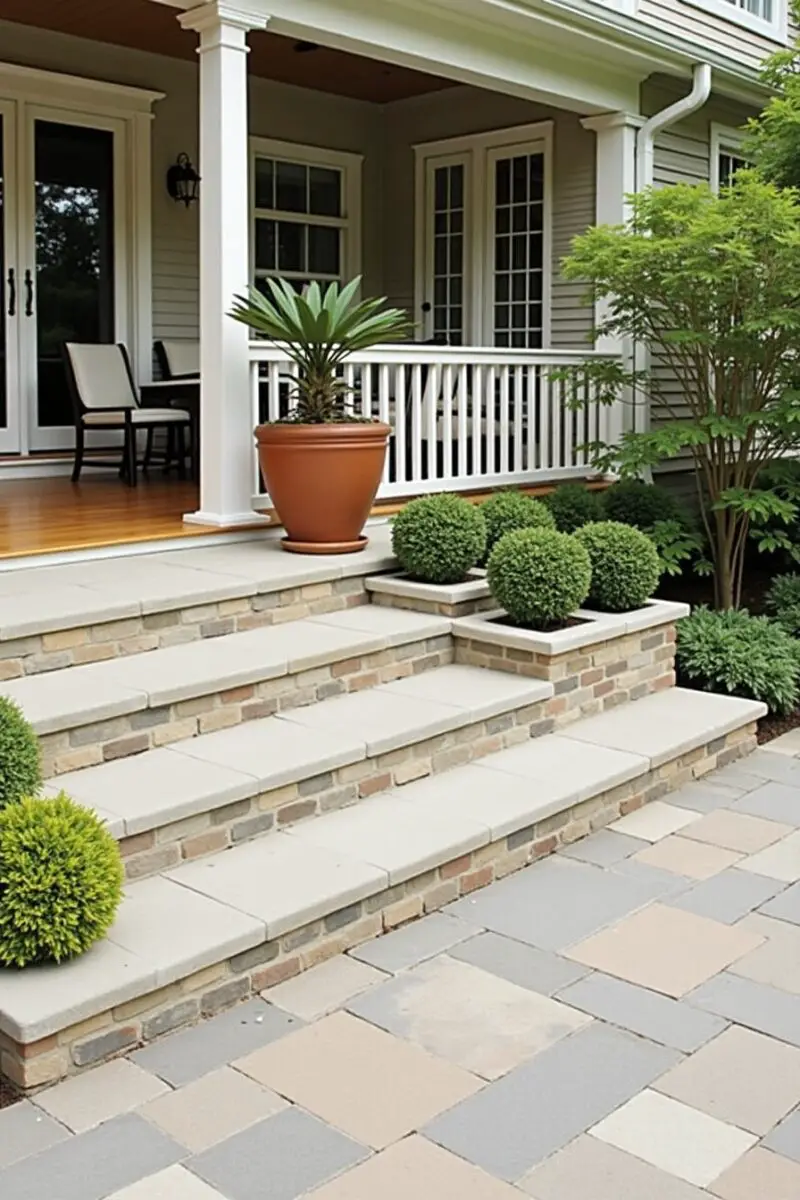
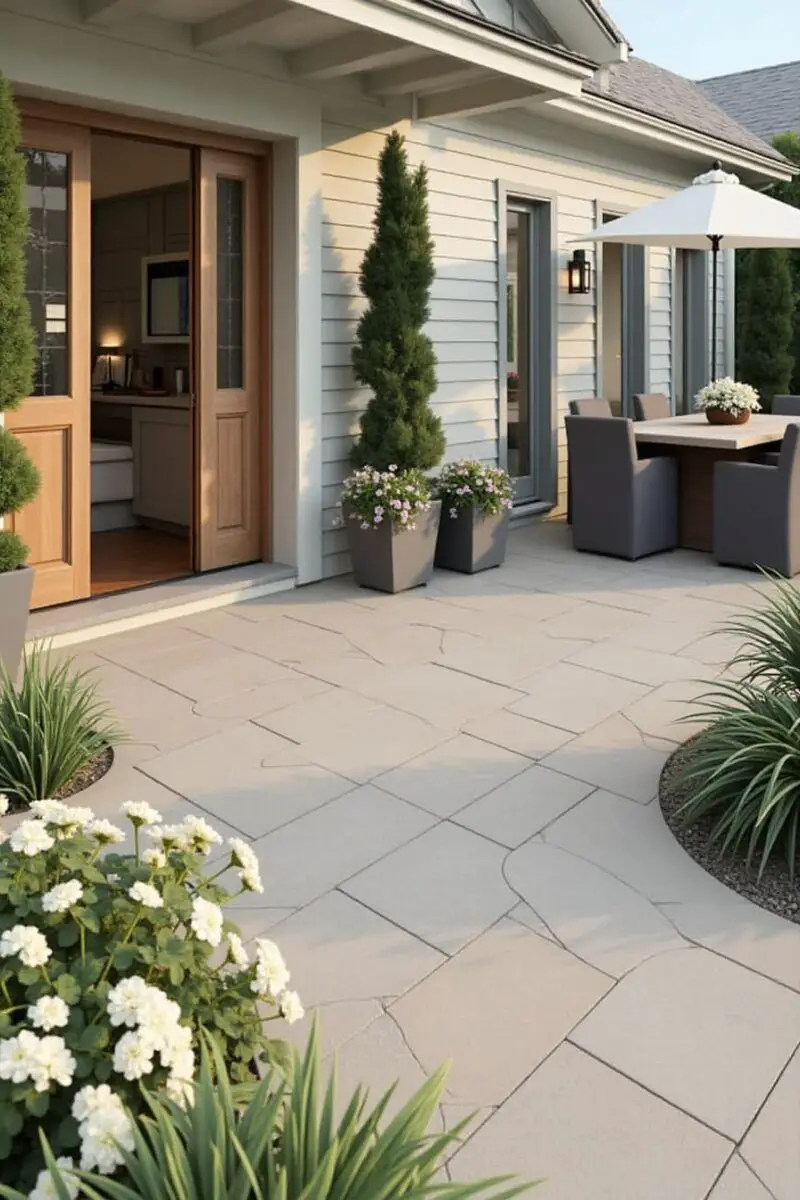
The most coveted outdoor spaces today blur the line between inside and outside, creating flowing transitions that extend your living area beyond four walls.
Using pavers that complement your interior flooring—perhaps in similar colors or complementary textures—creates visual continuity that draws the eye outward.
Consider matching the height of your interior floors and exterior patio for truly seamless transitions, eliminating threshold steps that interrupt the flow.
Large sliding or folding door systems that open completely transform the relationship between your indoor and outdoor spaces, especially when the same flooring material runs through both areas.
Weather-resistant fabrics and materials that echo your interior color scheme create cohesive design that doesn’t feel like two separate spaces.
Thoughtful lighting that maintains similar brightness levels between indoor and outdoor zones allows the spaces to function as one after sunset.
Temperature control elements like patio heaters, fans, and misting systems extend the seasons when your expanded living area functions as one cohesive space.
Covered portions of your paver patio create transition zones that function perfectly during light rain or intense sun, allowing you to move between spaces regardless of weather.
Consider how furniture arrangements can reinforce the connection—perhaps the back of your outdoor sofa aligns with your interior living room setup.
Load-bearing pavers installed over a properly prepared base can support outdoor kitchens and entertainment centers that truly replicate interior functionality.
For the ultimate luxury experience, retractable glass walls paired with matching interior and exterior paver surfaces create spaces that transform completely with the push of a button.
Consider acoustics in your design—sound-absorbing elements like water features can mask road noise and create pleasant audio environments similar to your home’s interior.
The psychological benefits of these connected spaces are significant—they make your home feel larger while creating stronger connections to nature and outdoor living.
Property values dramatically increase with professionally designed indoor-outdoor transitions, as these spaces top the wish lists of today’s homebuyers.
Even modest homes can achieve stunning indoor-outdoor connections through thoughtful paver selection and placement that visually extends limited square footage.
Climate considerations should guide your specific choices—desert climates might benefit from cooling paver colors, while northern exposures might need heat-retaining darker materials.
Water Wonders: Integrating Flowing Features with Your Paver Design

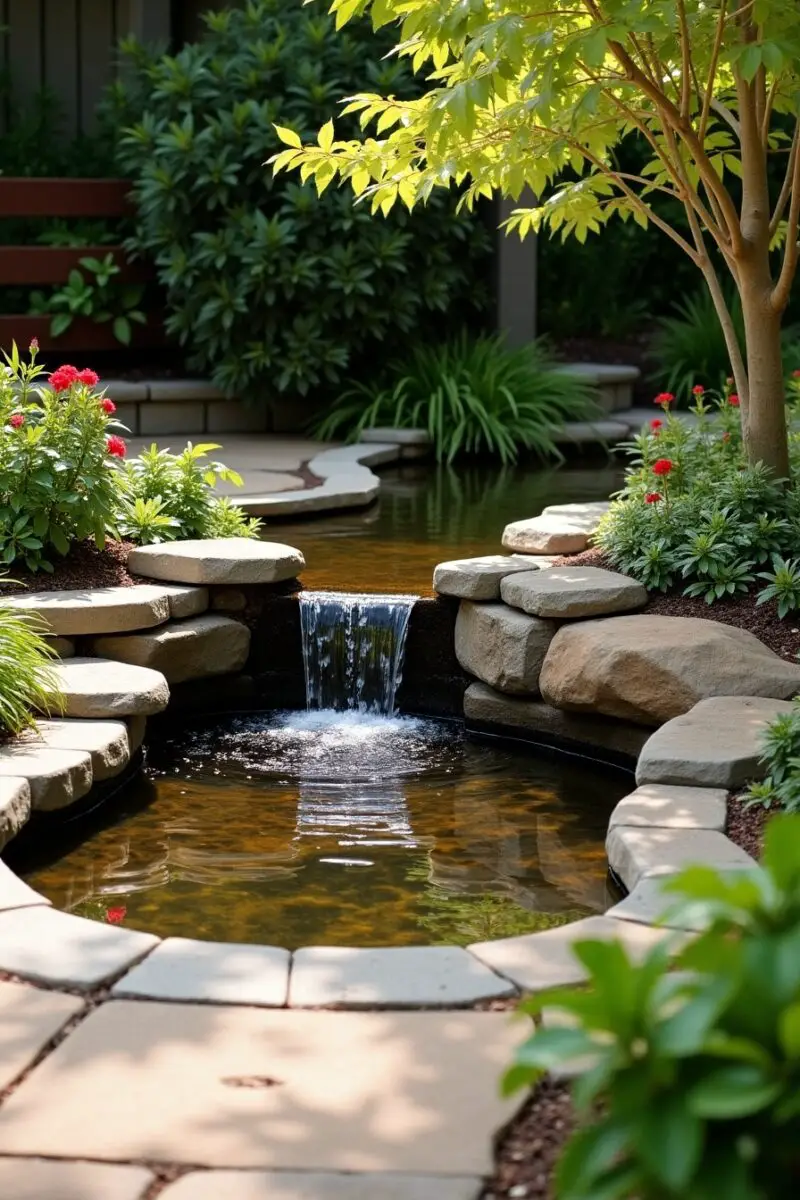
Water elements transform ordinary paver patios into sensory retreats, adding the soothing sounds and mesmerizing movement that take outdoor spaces from nice to unforgettable.
Unlike traditional water gardens that remain separate from living areas, integrated paver water features become part of your usable space, maximizing limited square footage.
Imagine stepping stones that appear to float across a shallow stream cutting through your patio—functional pathways that double as artistic water features.
The gentle bubbling of a millstone fountain centered in a paver patio creates a meditative focal point that masks neighborhood noise without overwhelming conversation.
For dramatic effect, consider water walls where sheets of water cascade over textured stone into paver-surrounded basins, creating both visual impact and soothing sounds.
Disappearing fountains that recirculate water through gaps between specially arranged pavers create the sound benefits of water features without open pools that might concern parents of young children.
Consider water channels that border your patio, defining edges with movement and sound while creating natural boundaries without obtrusive fencing.
The reflective qualities of water features dramatically enhance nighttime lighting, multiplying the impact of even modest illumination systems.
For sloped properties, a cascading waterfall incorporated into paver steps transforms a necessary transition into a stunning feature visible from multiple vantage points.
Paver-surrounded fire and water combinations create elemental contrast that instantly elevates your outdoor space into resort-worthy territory.
Smart water systems connected to home automation allow you to control flow rates, lighting effects, and schedules from your phone, impressing guests with theatrical control.
Consider how different paver colors appear when wet—intentionally selecting materials that enhance their appearance with moisture creates dynamic spaces that change with weather conditions.
The sound-masking qualities of water features create privacy in urban environments, allowing conversation without concern that neighbors will overhear every word.
Interactive water elements—like paver-surrounded jets that can be turned on for children’s play and off for adult entertaining—create multi-functional spaces for families.
The cooling effect of moving water can measurably decrease the ambient temperature around your patio, creating comfortable outdoor retreats even in warm climates.
Consider seasonality in your design—features that can be easily winterized or transformed for cold-weather use ensure year-round enjoyment of your investment.
Strategic placement of water elements near outdoor dining areas creates natural ambiance that restaurants pay designers thousands to achieve.
For truly innovative designs, consider musical water features where flow rates change to create different tones, adding an unexpected auditory element to your outdoor sanctuary.
✨Click to Get My 101 FREE Designer Room Ideas
Living Borders: Integrating Greenery with Your Paver Design for Softened Edges
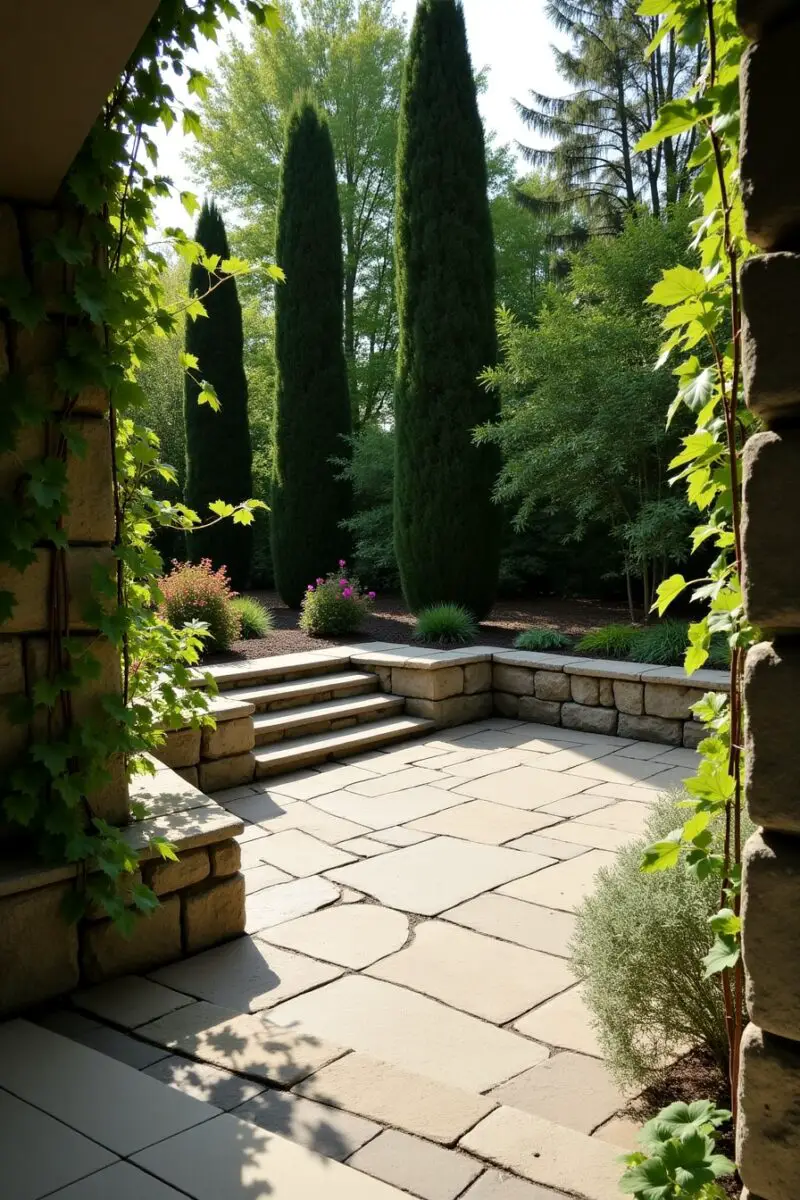
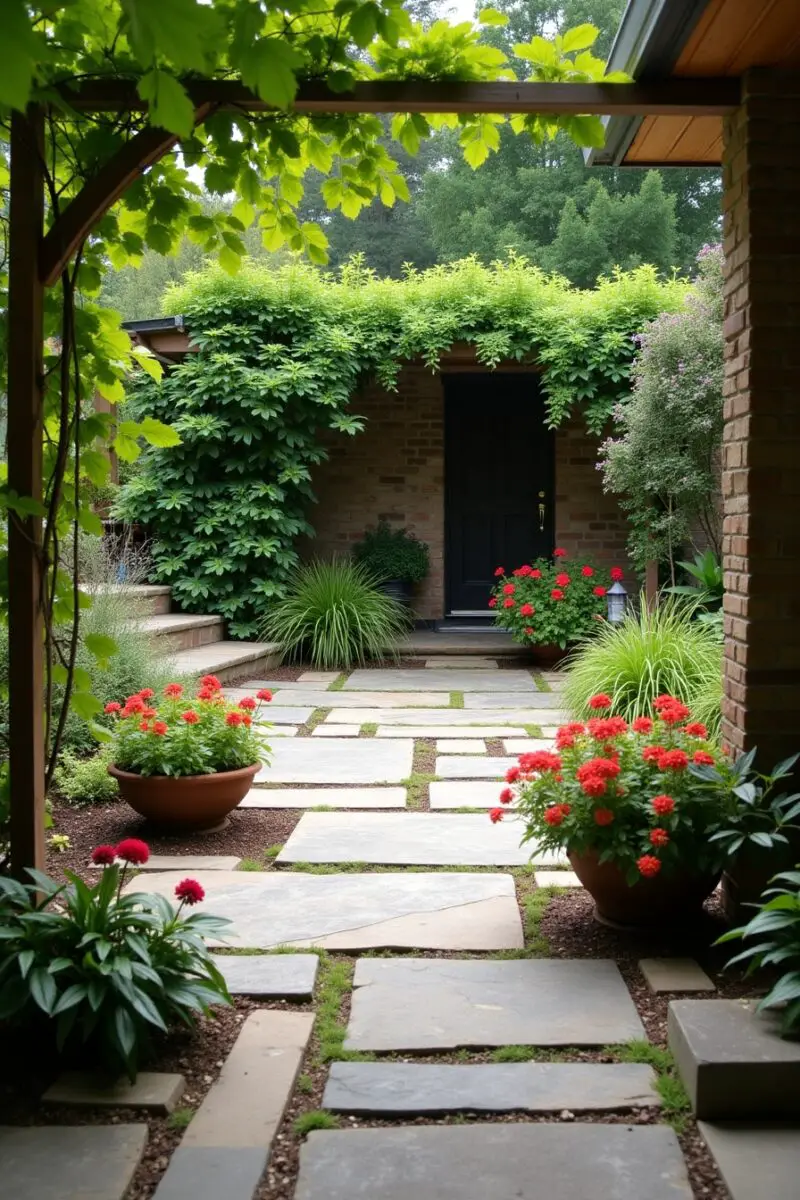
The most inviting paver patios blur the boundaries between hardscape and landscape, incorporating living elements that soften edges and breathe life into stone expanses.
Built-in paver planters create natural transitions between your structured patio and the surrounding garden, eliminating the “floating island” effect of traditional installations.
Imagine aromatic herbs spilling from stone containers positioned strategically near your outdoor kitchen—beauty and functionality in perfect harmony.
Consider raised paver beds that double as casual seating walls, their height carefully calculated to provide comfortable perching spots during large gatherings.
The temperature-moderating effect of integrated greenery creates microclimates within your patio space, with plants absorbing heat that would otherwise radiate from stone surfaces.
Strategic placement of taller plantings creates natural privacy screens that define outdoor rooms without constructing actual walls.
Alternating sections of pavers with ground cover plantings creates permeable “green joints” that add visual interest while improving drainage and reducing runoff.
Cascading plants that spill over the edges of integrated containers soften hard lines and create movement even on windless days.
Consider the sensory experience of your living edges—selecting plants with interesting textures, fragrances, and even gentle sounds as breezes pass through.
Tiered planters with varying heights create vertical interest in flat landscapes, drawing the eye upward and making modest spaces feel more expansive.
For low-maintenance appeal, carefully selected native plants require minimal watering once established and attract beneficial local wildlife to your outdoor retreat.
The contrast between structured pavers and organic plant forms creates visual tension that makes both elements more interesting than they would be alone.
Consider seasonal planning in your plant selection—ensuring visual interest during all months you’re likely to use your outdoor space.
Innovative “living paver” products with pre-engineered spaces for groundcover create uniform green patterns that combine the durability of stone with the softness of plants.
For dramatic effect, consider plants with architectural qualities—ornamental grasses that sway in the breeze or succulents with sculptural forms that complement your hardscape design.
The environmental benefits of integrated greenery include improved air quality, reduced heat island effect, and habitat creation for beneficial insects and birds.
For evening enjoyment, select some plants specifically for their nighttime qualities—white flowers that glow in moonlight or grasses that create beautiful shadows under landscape lighting.
Mixed Materials Magic: Combining Different Elements for Textured Paver Designs


The most visually striking paver patios often abandon single-material monotony in favor of mixed-media approaches that create textural conversations in your outdoor space.
Imagine the rich contrast between smooth concrete pavers and chunky natural stone sections—each material enhancing the other through juxtaposition.
Incorporating wood decking elements within paver frameworks creates warm, inviting sections that naturally draw guests toward seating areas.
Consider how different materials perform specific functions—perhaps smooth porcelain pavers for dining areas and textured natural stone for pathways that need traction.
The deliberate transition between materials creates natural room division without walls or barriers, subtly guiding movement through your outdoor living spaces.
Metal inlays between paver sections add unexpected industrial notes that complement contemporary architecture while creating wayfinding cues and visual interest.
The temperature differences between materials can actually enhance comfort—stone that stays cool underfoot near pool areas transitioning to warmer wood-look pavers for lounging.
Consider incorporating recycled glass pavers in strategic locations where sunlight can illuminate their jewel-like qualities, creating unexpected moments of delight.
The acoustic properties of different materials add sensory richness—the solid sound of footsteps on stone contrasting with the warmer tones of wood sections.
For truly distinctive designs, consider custom concrete pavers with embedded elements like fossils, glass, or metal that create one-of-a-kind conversational features.
Permeable pavers in strategic sections address drainage concerns while creating visual rhythm through their distinctive open-grid appearance.
The weathering properties of mixed materials create patios that evolve beautifully over time—some elements developing rich patinas while others maintain their original appearance.
Consider how seasonal changes affect your material choices—perhaps incorporating darker heat-absorbing sections in areas used primarily during cooler months.
The maintenance requirements of different materials should inform their placement—save higher-maintenance options for showcase areas rather than high-traffic pathways.
For dramatic effect, consider how water interacts with different surfaces—some darkening richly when wet while others maintain their appearance regardless of weather.
Material transitions create natural opportunities for incorporating drainage solutions, lighting elements, or level changes that add functionality and visual interest.
The color psychology of different materials can subtly influence the mood of various outdoor zones—cooler tones for relaxation areas and warmer, energizing hues for entertainment spaces.
Consider how different paver materials complement your home’s architecture—perhaps drawing stone types from your facade or matching brick details for cohesive design language.
For maximum visual impact, limit your mixed-media palette to three primary materials that create clear relationships rather than chaotic competition.
Night Magic: Illuminated Paver Designs That Transform After Dark
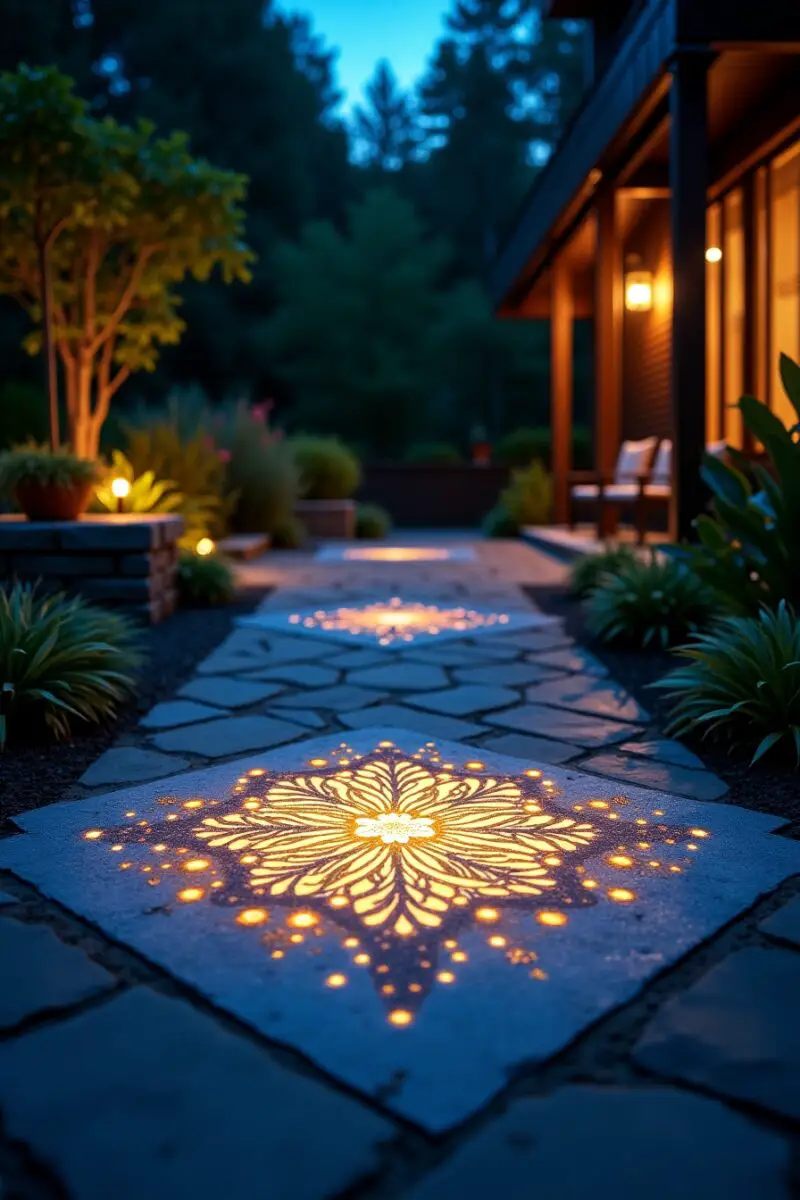

Unlike traditional spotlights that create harsh shadows, lights recessed between paver joints produce illumination that seems to emanate from the ground itself.
Imagine pathway markers that guide guests intuitively through your outdoor space without the institutional feel of traditional bollard lighting.
Translucent pavers with LED systems beneath create dramatic effects impossible to achieve with surface lighting—entire sections of your patio can glow with color that can change with seasons or moods.
Consider how lighting can highlight the textural qualities of your pavers—grazing lights placed at low angles cast shadows that emphasize the natural variations in stone surfaces.
Stair tread lighting integrated into paver steps transforms necessary safety features into architectural elements that define vertical transitions after dark.
The reflective qualities of certain paver materials can multiply lighting effects, creating sparkle and movement that brings static surfaces to life.
Consider how different lighting temperatures affect the appearance of your materials—warm lights enhancing redbrick tones while cool LEDs complement bluestone or slate.
Interactive lighting systems connected to smart home technology allow your paver patio to respond to music, change with weather conditions, or signal when dinner is ready.
The psychological impact of well-designed landscape lighting extends beyond aesthetics—properly illuminated outdoor spaces create security and comfort that encourage evening use.
Unlike temporary lighting solutions, integrated paver systems withstand weather extremes and regular traffic, providing years of maintenance-free illumination.
Consider energy efficiency in your design—solar-charging pavers that collect sunlight by day to power subtle illumination after dark create self-sustaining systems.
The drama of silhouette lighting—where lights shine upward through plants surrounding your patio—creates theatrical effects that transform everyday landscapes into extraordinary evening retreats.
For entertaining spaces, consider programmable paver lighting that can shift from subtle dinner ambiance to energetic party modes with a simple smartphone command.
The transitional moments—dusk and dawn—showcase the versatility of well-designed paver lighting as artificial illumination gradually complements or replaces natural light.
Consider how lighting reveals the dimensional qualities of patterns or designs that might seem subtle during daylight but become prominent features after dark.
For the ultimate luxury touch, heated paver systems can be integrated with the same infrastructure that powers your lighting, creating outdoor spaces that remain comfortable well into cooler seasons.
The value of properly illuminated paver spaces extends your usable hours, effectively doubling the return on your outdoor living investment.
Consider the view from inside your home when designing paver lighting—the most successful systems create beautiful nighttime landscapes visible through windows, extending enjoyment even when you’re indoors.
The magical quality of thoughtfully illuminated paver patios creates immersive environments that disconnect guests from digital distractions, fostering conversation and connection under the stars.
Eco-Friendly Solutions: Sustainable Paver Options That Look Amazing
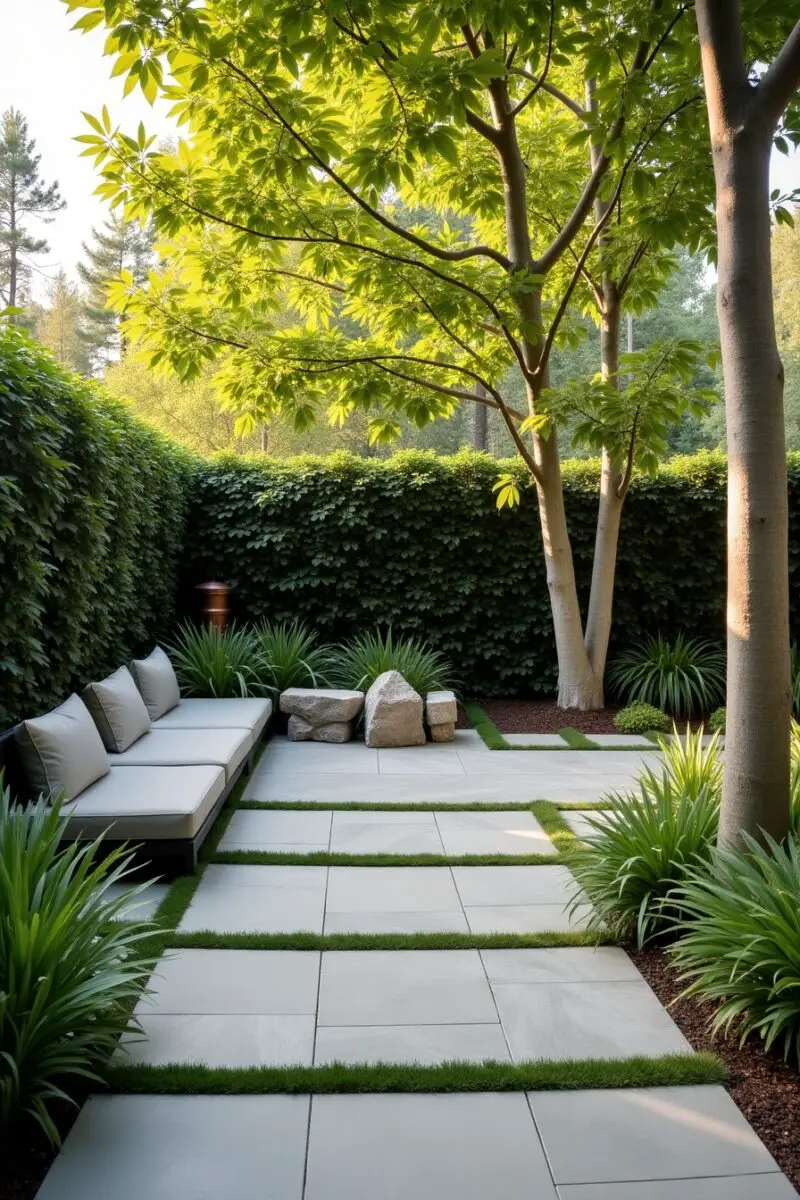
The most forward-thinking paver patios prove that environmental responsibility and stunning design can coexist beautifully in your outdoor sanctuary.
Unlike impermeable concrete slabs that contribute to storm water runoff issues, permeable paver systems allow rainwater to naturally filter through to the soil, replenishing groundwater and reducing flooding risks.
Imagine the satisfaction of knowing your beautiful outdoor space actually improves your local ecosystem rather than stressing it further.
Recycled material pavers—created from crushed glass, reclaimed concrete, or repurposed plastic—transform waste streams into durable, attractive outdoor surfaces with unique aesthetic qualities.
Consider how locally-sourced natural stone reduces the carbon footprint associated with transportation while often providing better weathering properties specific to your climate.
The thermal benefits of light-colored, reflective pavers significantly reduce heat island effects, creating more comfortable outdoor environments while decreasing cooling costs for adjacent indoor spaces.
Unlike chemically-treated wood decking that requires regular application of preservatives, sustainable paver materials remain beautiful for decades without harmful maintenance routines.
Consider integrating rainwater collection systems with your paver design, channeling runoff from roofs into decorative retention features that double as landscape elements.
The modularity of paver systems allows for easy repair and replacement of individual units—a significantly more sustainable approach than demolishing and replacing entire concrete sections.
For eco-conscious homeowners, living paver systems with engineered gaps for groundcover create the perfect balance between durable surfaces and permeable green spaces.
Consider how your paver choices might contribute to habitat creation—certain materials and configurations create perfect environments for beneficial insects and native plant species.
The long-term resilience of properly installed paver systems represents sustainability in its most practical form—materials that won’t need replacement for generations.
The seasonal adaptability of well-designed paver systems reduces the need for resource-intensive modifications as weather patterns change throughout the year.
For true environmental leadership, consider pavers with photocatalytic surfaces that actually neutralize air pollutants when exposed to sunlight, turning your patio into an air-purifying asset.
The water management capabilities of properly designed paver systems can eliminate the need for chemical treatments to control moss and algae, reducing toxic runoff into local waterways.
For budget-conscious environmentalists, certain sustainable paver options actually cost less over time than conventional materials when maintenance requirements and longevity are factored in.
The growing availability of innovative eco-friendly paver options means you no longer need to choose between environmental values and creating the outdoor retreat of your dreams.
✨Click to Get My 101 FREE Designer Room Ideas
Spa-Inspired Sanctuaries: Paver Designs for Ultimate Relaxation Retreats

Nothing transforms an ordinary backyard into a luxury retreat quite like a spa-inspired paver patio designed specifically for relaxation and wellness.
Unlike traditional deck surrounds for hot tubs, a thoughtfully designed paver spa zone creates an immersive wellness experience that rivals high-end resorts.
Imagine strategically placed pavers with inlaid river stones that provide reflexology benefits as you walk barefoot between soaking areas and cooling zones.
Consider how different elevations create natural transitions between hot tub platforms, cooling lounges, and meditation spaces, each with distinctive paver patterns that signal their purpose.
The slip-resistant textures of properly selected pavers provide crucial safety features around water elements while maintaining the sophisticated aesthetic of your wellness retreat.
For true indulgence, consider incorporating a paver-surrounded cold plunge adjacent to your hot soak area, creating the circulation-boosting contrast that luxury spas charge premium prices to experience.
The thoughtful incorporation of aromatherapy through integrated herb planters—lavender, mint, and rosemary placed where steam or foot traffic will release their calming scents—engages multiple senses in your relaxation routine.
Consider how proper drainage design can transform your outdoor shower from a merely functional element to a rainfall-inspired luxury with water disappearing through elegantly spaced pavers.
All-Season Adaptability: Creating a Year-Round Usable Paver Patio
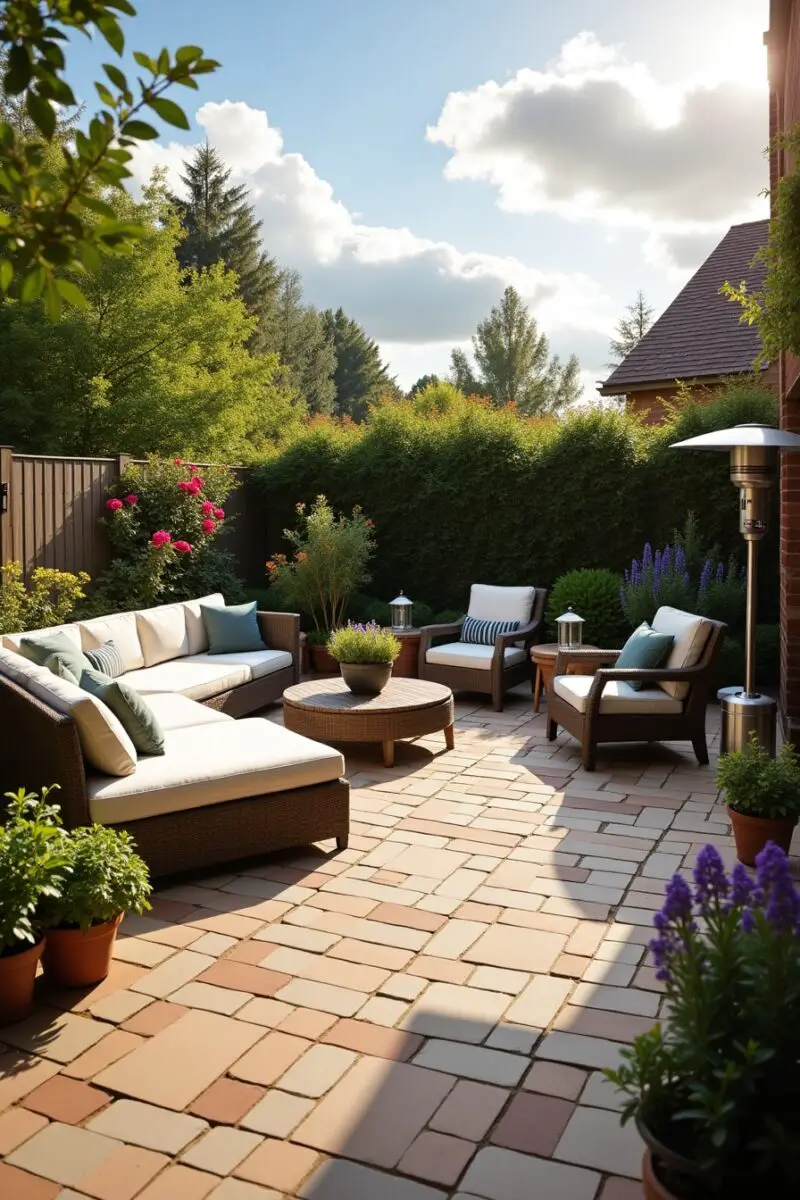

The true measure of a successful paver patio isn’t how it performs during perfect weather, but how many additional days throughout the year it remains comfortably usable.
Unlike fair-weather outdoor spaces that sit abandoned during temperature extremes, a thoughtfully designed all-season patio extends your enjoyment from early spring through late fall—or even year-round in moderate climates.
Imagine starting your day with coffee outdoors in early March or hosting Thanksgiving dinner under the stars because your paver patio incorporates practical elements that address temperature, precipitation, and comfort in changing conditions.
Consider orienting your main seating areas to capture maximum winter sun while incorporating structural elements like pergolas or strategically placed trees that provide critical summer shade when the sun’s angle changes.
The material selection for all-season patios deserves special attention—perhaps darker pavers in areas used primarily during cooler months to absorb and radiate heat, with lighter colors in summer-use zones to reflect heat when temperatures rise.
For truly extended seasonal use, consider incorporating a partially covered section with clear weatherproof panels that allow sunlight while blocking rain and snow—creating a transitional space between fully exposed and fully enclosed areas.


